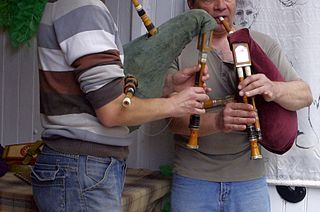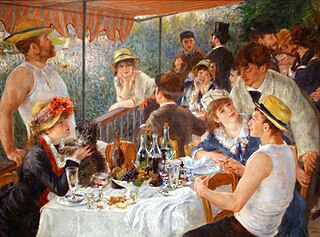Related Research Articles

Bagpipes are a woodwind instrument using enclosed reeds fed from a constant reservoir of air in the form of a bag. The Scottish Great Highland bagpipes are the best known examples in the Anglophone world, but people have played bagpipes for centuries throughout large parts of Europe, Northern Africa, Western Asia, around the Persian Gulf and northern parts of South Asia.
The music of France reflects a diverse array of styles. In the field of classical music, France has produced several prominent romantic composers, while folk and popular music have seen the rise of the chanson and cabaret style. The earliest known sound recording device in the world, the phonautograph, was patented in France by Édouard-Léon Scott de Martinville in 1857. France is also the 5th largest market by value in the world, and its music industry has produced many internationally renowned artists, especially in the nouvelle chanson and electronic music.
Bal-musette is a style of French instrumental music and dance that first became popular in Paris in the 1880s. Although it began with bagpipes as the main instrument, this instrument was replaced with accordion, on which a variety of waltzes, polkas, and other dance styles were played for dances.
Musette may refer to:
The piccolo oboe, also known as the piccoloboe and historically called an oboe musette, is the smallest and highest pitched member of the oboe family. Pitched in E♭ or F above the regular oboe, the piccolo oboe is a sopranino version of the oboe, comparable to the E♭ clarinet. It is most commonly found in early 20th-century marching band music, and the occasional rare chamber music ensembles or contemporary compositions.
Jazz music has been popular in France since the 1920s. Its international popularity peaked in the 1930s, and it has been continually enjoyed since.

Squeeze Play is an Ultra High Fidelity monaural phonographic album which was released on the Dot Records label in 1956 (DLP-3024) featuring John Serry Sr. It includes an original composition by Serry, classical works, and popular music of the era. Ben Selvin serves as the musical director/producer for the album. The works were arranged by Serry and performed with his ensemble featuring two accordions, piano, guitar, bass, drum, vibes, and marimba.

French bagpipes cover a wide range and variety of styles of bagpipes and piping, from the Celtic piping and Music of Brittany to the Northern Occitan's cabrette.

The musette de cour or baroque musette is a musical instrument of the bagpipe family. Visually, the musette is characterised by the short, cylindrical shuttle-drone and the two chalumeaux. Both the chanters and the drones have a cylindrical bore and use a double reed, giving a quiet tone similar to the oboe. The instrument is blown by a bellows.

Nicolas Chédeville was a French composer, musette player and musette maker.
Pierre-Claude Foucquet was a French organist and harpsichordist.

The Guinguette was a popular drinking establishment in the suburbs of Paris and of other cities in France. Guinguettes would also serve as restaurants and often as dance venues. The origin of the term comes from guinguet, indicating a sour white light local wine.
Java is a dance which was developed in France in the early part of the 20th century. The origin of its name is uncertain, but it probably evolved from the valse.

The Fortune Teller is an operetta in three acts written by Victor Herbert, with a libretto by Harry B. Smith. After a brief tryout in Toronto, it premiered on Broadway on September 26, 1898 at Wallack's Theatre and ran for 40 performances. Star Alice Nielsen and many of the original company travelled to London where the piece opened at the Shaftesbury Theatre on April 9, 1901, running for 88 performances. It was revived in New York on November 4, 1929 at Jolson's 59th Street Theatre and ran for 16 performances.

Alba-la-Romaine is a commune in the Ardèche department in the Auvergne-Rhône-Alpes region of southern France.

A haversack or small pack is a bag with a single shoulder strap. Although similar to a backpack, the single shoulder strap differentiates this type from other backpacks. There are exceptions to this general rule.

Bages is a commune in the Aude department in the Occitanie region of southern France.

Chouppes is a commune in the Vienne department in the Nouvelle-Aquitaine region in western France.
The surdelina or sampogna was a kind of bag pipe which was described and illustrated by Mersenne as the musette de Naples; its construction was very complicated. Mersenne states that the instrument was invented by Jean Baptiste Riva, Dom Julio and Vincenze; but Mersenne seems to have made alterations himself in the original instrument, which are not very clearly explained. There were two chaunters with narrow cylindrical bore and having both finger-holes and keys; and two drones each having ten keys. The four pipes were fixed in the same stock, and double reeds were used throughout; the bag was inflated by means of bellows. Passenti of Venice published a collection of melodies for the zampogna in 1628, under the title of Canora Zampogna.
References
- ↑ Auvergne. Pierre-François Aleil, Pierre Bonnaud, Eric Bordessoule, Caroline Roux, Pierre Charbonnier. Christine Bonneton, 2005. ISBN 2-86253-331-9, ISBN 978-2-86253-331-5. Pg 146